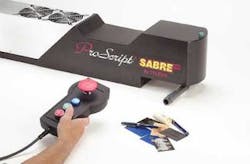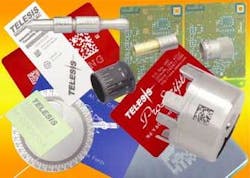Selecting a marking system
Sam Yerardi
When selecting a system for laser marking a part with a serial number, logo or barcode identification information, you must consider several criteria: the information to be marked, the required marking speed, the type of physical mark and the material to be marked. Once chosen, the parameters within the marking technology need to be specified. Potential buyers should investigate sample marking of their parts with a respective laser marking system vendor before making a final decision. Criteria such as power and frequency, as outlined below, can only be determined by sample marking the part. Also, buyers should note that there could be interplay between some of these factors.
Material determines wavelength
Selecting a laser marking system involves choosing the proper wavelength for the material to be marked. Marking applications can cover a wide range of laser wavelengths: Nd:YAG (1064 nm), CO2 (10.6 µm) and other infrared wavelengths as well as light in the visible spectrum. Other laser types such as green (532 nm) and UV are also used for industrial applications. The two major choices for most industrial applications are Nd:YAG (1064 nm) and CO2 (10.6 µm), each working best with an array of materials. A suggested rule of thumb for selecting the proper wavelength is to use the "microwave oven" example: If it is something that you could put in a microwave oven (that is, something organic, not metal), it is probably a CO2 application—not always, but usually. If it is something you would not put into a microwave oven (something metal) it is probably a Nd:YAG application—again, not always, but usually.
null
All materials will, at room temperature, absorb, transmit, refract and/or reflect light energy at a particular wavelength or range of wavelengths. The ability of a material to absorb light and thus react in some manner to that energy is the desired property. For example, CO2 lasers excel at marking anodized aluminum, plastics, wood, glass and ceramics. Ferrous metals can also be marked. A CO2 laser is a good choice when an engraved mark in plastic (without a color contrast) is desired. Glass can also be marked using CO2 lasers with a process known as controlled fracturing.
Nd:YAG lasers are well suited for most metals, and some types of plastics where a color-contrast is desired. A color-contrast mark in most steels is easily achievable with Nd:YAG. Most Nd:YAG lasers can develop very high peak pulse energies due to a process known as
Q-switching, which allows a greater amount of the light energy to be delivered to the workpiece. Also, the Nd:YAG laser has a shorter wavelength than the CO2, so, with a similar lens and M2 value, the Nd:YAG laser is capable of a much smaller beam diameter at the workpiece than the CO2. This allows a much greater concentration of light energy at the workpiece. M2, a dimensionless number, is the ratio between the theoretical focal point of a pure Gaussian beam and the actual focal point of the laser in question. For this discussion, Gaussian describes the energy profile (known as a Gaussian distribution), distributed across the cross-section of the beam. As the M2 value approaches 1, the beam quality gets better, and the better the beam quality, the better the resultant mark.
null
Lamp-pumped vs. diode-pumped lasers
If you are marking with Nd:YAG, it may be necessary to choose between lamp-pumped or diode-pumped technology. Two factors need to be considered; the required power for the application and the economic tradeoffs between lamp-pumped and diode-pumped technologies. Currently, most diode-pumped systems are rated at 50 W (CW) or less. Thus if the application requires more than 50 W (CW), lamp-pumped technology is probably the better choice. Lasers generate a quantity of internal heat that must be removed for efficient operation. Lamp-pumped laser systems draw more power and generate the most heat, but are relatively inexpensive to maintain on an annual basis. The consumables for a lamp-pumped system consist of the lamp and any air or water filtration that is used. Lamps may have to be changed approximately every 600–800 hours if operated continuously at high operating levels, or every 1000–1200 hours for less demanding operation. Annual maintenance costs can range from $2,000 to $3,000.
Diode-pumped systems generate less heat, are more efficient and require less maintenance because laser diodes are used to pump the crystal rather than an arc lamp. Lamp-pump lifetimes are measured in hundreds of hours, while diode-pump lifetimes are measured in thousands of hours. While an arc lamp may cost less than $200, a diode-pumping chamber will be $5,000 or more (depending on the number of diodes), but diode lifetimes range from 5,000 hours to upwards of 10,000 hours or more. For a typical shop, operating 2,000 hours per year at less than maximum power, the diode-pump approach could last several years or more without ever requiring change-out of the pumping chamber.
Prospective buyers with other lasers in place may find it makes sense to stay with the technology currently in use. Spare parts and previous experience with the systems currently in place will make it an easier choice. However, for a first-time buyer, considering diode-pumped technology might make sense.
Power
Getting the right amount of energy delivered to the part for the right amount of time is the essence of laser marking. For a given material, there will be a change in the material as a result of its interaction with laser energy converted to heat (power).
For most CO2 marking lasers, energy is delivered in the form of a continuous wave (CW) beam. A constant average level of laser energy is delivered and is switched on and off as required. Q-switched Nd:YAG lasers achieve high peak powers, allowing a greater amount of laser energy to be delivered in a unit amount of time. By controlling the rate at which the energy is applied, different peak values of laser energy can be developed.
Marking speed
Buyers need to establish the desired process cycle time to determine the required marking speed. Most systems mark by steering the beam with X and Y galvanometers, with attached mirrors. Marking speeds are difficult to quantify and the buyer is advised to confirm a vendor's claim about various marking speeds. It can be difficult to translate 'marking speed' directly into characters per second for all cases because a wide range of factors must be considered. For example, a single-stroke takes less time to mark than one more elaborate. The size of the character—its height, width and pitch (spacing between the respective characters)—will also be a factor.
Another factor that will have an impact on the achievable speed is the amount of power that needs to be applied, the amount of time that energy needs to be delivered and the frequency at which the laser system needs to be pulsed (if the energy requirement dictates the need for pulsing).
Integration
The laser beam delivery system must be physically capable of accommodating the part. The focal point of the lens must be able to reach the required area without conflicting with the part itself. Most system vendors can provide their systems integrated into a workstation, and some offer full system integration. This is extremely important for applications other than job shops; however, these applications can present myriad integration challenges. Custom mounting of the laser with respect to the part, location of controls, software integration with the customer and unique fixturing are all aspects of laser system integration that should be provided by the laser marking system vendor.
Software
Laser marking system software must be intuitive. The ability to handle a wide range of graphics file formats and fonts is essential, and the software should allow easy implementation and control of I/O as well as motion control. A laser marking system that allows real-time control of the laser marking process is also important. For example, if the laser system requires that a part program be downloaded to the laser controller from a PC first, it is less flexible than a system that can operate directly from PC control. The laser system software should provide the functionality required without requiring custom modification.
Safety
Laser marking systems are manufactured and operated under compliance with governmental standards. Manufacturers have to comply with CDRH (FDA) to determine the classification of the laser, either Class 1, 2, 3a, 3b or a Class 4 laser. Users of the laser have to comply with ANSI Z136.1-2000.
A Class 1 system is safe for human eyesight, and no special eyesight precautions need to be taken during operation. Most laser marking system vendors can provide their systems in this manner, utilizing special shielding and housings that can be tailored to the part or operation. It is important that you only consider laser vendors that can provide these features.
A Class 4 system provides no protection; thus certain required precautions and controls need to be implemented by the user. In other words, the laser system will either need to be operated in a room with adequate guarding and protection as defined, or the user will need to provide shielding as defined in the ANSI Z136.1-2000 standard. All laser marking system vendors should be able to explain this and provide the necessary information and support for the user to safely operate the laser system in this manner. Buyers should not consider a laser vendor that is unable to do this.
Conclusion
Choosing a laser marking system can be a daunting task. By following a plan based on the guidelines set forth in this article, the prospective laser buyer can feel more comfortable in knowing that they have made an informed decision. Also, the prospective buyer should feel comfortable with the prospective vendor. Make sure the vendor answers your questions and can give you the names of other customers for reference. Strive to have a full understanding of how different vendors compare—not only in laser specifications but also in what is included in the entire package. Consider every issue—training, site installation and so on.
Sam Yerardi is the laser development engineer with Telesis Technologies Inc. in Circleville, Ohio. Sam can be contacted at (740) 477-5000 or e-mail at [email protected].


